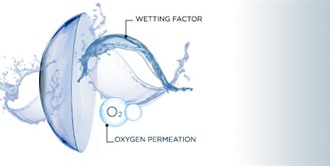Contact lenses are thin pieces of plastic that sit on the surface of the eye, their function for the most part is to correct vision defects, but they are also used for cosmetic purposes, eye bandages and to help treat eye conditions.
The first soft contact lenses were launched in the 1970’s, made from water loving gels called Hydrogels, they became popular quickly due to how comfortable they were to wear in comparison to the rigid hard gas permeable contact lenses.
Hydrogel lenses are typically very thin, they drape and mold comfortably over of the eye surface causing minimal lid sensitivity, so the wearer hardly feels they are wearing a contact lens. Hydrogels are also biocompatible and so are suitable for even the most sensitive of eyes.
Early on Hydrogel contact lenses dried out quickly and wearers would often suffer from end of day dryness and discomfort. More concerning was the Hydrogel material reduce the levels of oxygen flowing thru the lens to the cornea which affected ocular health, especially in patients who over wore their lenses. Cases of Hypoxia increased as wearers suffered from corneal swelling, burning sensations, increased tearing, itchy red eyes, blurry vision and were exposed to an increased risk of eye infections.
To address the reduced oxygen transmissibility issue of the early Hydrogel contact lenses, Silicone Hydrogel contact lenses were introduced in the late 1990’s. The silicone mixed with the hydrogel allowed up to 5 times more oxygen to pass thru the lens to the cornea therefore protecting the health of the eye and reducing the cases of presenting Hypoxia, plus it gave wearers the ability to wear their contact lenses safely for longer periods.
Silicone Hydrogel lenses had their tradeoffs too, with the reduction of the water loving particles of hydrogel being replaced by silicone the lens became dehydrated faster, it was stiffer and thicker, plus the increased oxygen levels allowed the cornea to maintain its normal sensitivity which increased lens awareness in the eye. The addition of silicone also caused some patients to experience allergy like symptoms.
Today hydrogel and silicone hydrogel materials are still widely used, however advancements in technologies have helped to manage their limitations with the use of moisture treatments, dehydration barriers, manufacturing, and lens technologies. Contact lens categories have improved also with the availability of lenses not only for short and longsightedness but astigmatism and multifocal visual needs too, in daily, fortnightly, monthly, and extended wear options.
Examples of the current technologies in hydrogel daily contact lenses is the popular 1 Day Acuvue Moist and Dailies Aquacomfort Plus. 1 Day Acuvue Moist lenses feature Lacreon technology whereas Dailies Aquacomfort Plus lenses feature a blink release moisturizing agent, resulting in both lenses providing long hours of comfortable wear.
Coopervision Myday are daily silicone hydrogel contact lenses that incorporate “smart silicone” which they say has struck the right balance between silicone and hydrogel delivering the much-needed oxygen to the cornea while retaining moisture for a long day of comfortable wear.
Dailies Total 1 are a daily silicone hydrogel, which feature the worlds first water gradient contact lenses, holding water in the lens where the eye needs it most, delivering an exceptionally comfortable wearing experience with high oxygen transmissibility.
So which lens is suitable for you ? Well, this is the six million dollar question and one that your Optical practitioner can help you with, once they have accessed the health of your eyes and vision needs. This blog is intended to give you some background on contact lens materials, their advantages and disadvantages so you can be informed, discuss the options with your optical practitioner and have an understanding of what you are putting in your eye.

